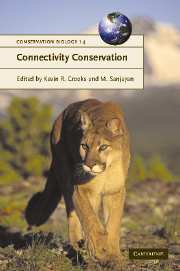Book contents
- Frontmatter
- Contents
- List of contributors
- Acknowledgements
- 1 Connectivity conservation: maintaining connections for nature
- PART I Approaches to connectivity research
- Introduction: Connectivity research—what are the issues?
- 2 Landscape connectivity: a return to the basics
- 3 Connectivity and metapopulation dynamics in highly fragmented landscapes
- 4 Genetics and landscape connectivity
- 5 Connectivity at the land–water interface
- 6 Influence of natural landscape fragmentation and resource availability on distribution and connectivity of gray wolves (Canis lupus) in the archipelago of coastal British Columbia, Canada
- 7 Migratory connectivity
- 8 Connectivity in marine ecosystems: the importance of larval and spore dispersal
- 9 Connectivity and wide-ranging species in the ocean
- 10 Hydrologic connectivity: a neglected dimension of conservation biology
- 11 Connectivity and ecosystem services: crop pollination in agricultural landscapes
- PART II Assessing connectivity
- PART III Challenges and implementation of connectivity conservation
- Index
- References
3 - Connectivity and metapopulation dynamics in highly fragmented landscapes
Published online by Cambridge University Press: 24 May 2010
- Frontmatter
- Contents
- List of contributors
- Acknowledgements
- 1 Connectivity conservation: maintaining connections for nature
- PART I Approaches to connectivity research
- Introduction: Connectivity research—what are the issues?
- 2 Landscape connectivity: a return to the basics
- 3 Connectivity and metapopulation dynamics in highly fragmented landscapes
- 4 Genetics and landscape connectivity
- 5 Connectivity at the land–water interface
- 6 Influence of natural landscape fragmentation and resource availability on distribution and connectivity of gray wolves (Canis lupus) in the archipelago of coastal British Columbia, Canada
- 7 Migratory connectivity
- 8 Connectivity in marine ecosystems: the importance of larval and spore dispersal
- 9 Connectivity and wide-ranging species in the ocean
- 10 Hydrologic connectivity: a neglected dimension of conservation biology
- 11 Connectivity and ecosystem services: crop pollination in agricultural landscapes
- PART II Assessing connectivity
- PART III Challenges and implementation of connectivity conservation
- Index
- References
Summary
INTRODUCTION
Connectivity is a key variable in spatial ecology (MacArthur and Wilson 1967; Levin 1974; Hanski 1998; Tishendorf and Fahrig 2000; Moilanen and Hanski 2001; King and With 2002), and the element that turns a conventional population study (or a model) into a spatial one. Broadly speaking, connectivity measures the effect of landscape structure on movements of individuals, but in spite of the pivotal role of this measure in ecology, there is no generally accepted and employed formal definition of connectivity (Crooks and Sanjayan Chapter 1). In particular, the way connectivity is used in metapopulation ecology is different from its use in landscape ecology (Tishendorf and Fahrig 2000; Moilanen and Hanski 2001; With 2004; Taylor et al. Chapter 2). In metapopulation ecology, connectivity is seen as a property of a habitat patch (or a grid cell), and the measure of connectivity is defined via predicted rate of immigration into a patch or via predicted success of migrants leaving a patch.
In landscape ecology, connectivity is viewed as a property of an entire landscape – a measure of how much, or how little, landscape structure hinders movements (Taylor et al. 1993; With 2004; Taylor et al. Chapter 2). This difference in the spatial scale is reflected in the use of connectivity in modeling. Nonetheless, both metapopulation and landscape ecology are concerned with the same phenomena, the effects of landscape structure on migration, colonization success, and the persistence of species at the landscape level.
- Type
- Chapter
- Information
- Connectivity Conservation , pp. 44 - 71Publisher: Cambridge University PressPrint publication year: 2006
References
- 18
- Cited by



